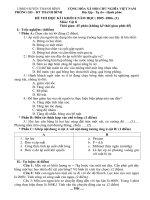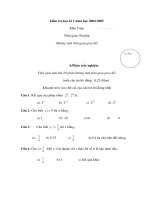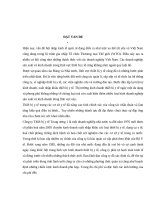LINEAR PROGRAMMING 1 APPLIED ALGORITHMS SPRING 2005 LINEAR PROGRAMMING LECTURE 4 - LINEAR PROGRAMMING 2
Bạn đang xem bản rút gọn của tài liệu. Xem và tải ngay bản đầy đủ của tài liệu tại đây (101.5 KB, 64 trang )
CSEP 521
Applied Algorithms
Spring 2005
Linear Programming
Lecture 4 - Linear Programming 1
Reading
• Chapter 29
Lecture 4 - Linear Programming 2
Outline for Tonight
• Examples of Linear Programming
• Reductions to Linear Programming
• Duality Theorem
• Approximation algorithms using LP
• Simplex Algorithm
Lecture 4 - Linear Programming 3
Linear Programming
• The process of minimizing a linear objective function
subject to a finite number of linear equality and
inequality constraints.
• The word “programming” is historical and predates
computer programming.
• Example applications:
– airline crew scheduling
– manufacturing and production planning
– telecommunications network design
• “Few problems studied in computer science have
greater application in the real world.”
Lecture 4 - Linear Programming 4
An Example: The Diet Problem
• A student is trying to decide on lowest cost diet that
provides sufficient amount of protein, with two choices:
– steak: 2 units of protein/pound, $3/pound
– peanut butter: 1 unit of protein/pound, $2/pound
• In proper diet, need 4 units protein/day.
Let x = # pounds peanut butter/day in the diet.
Let y = # pounds steak/day in the diet.
Goal: minimize 2x + 3y (total cost)
subject to constraints: This is an LP- formulation
x + 2y ≥ 4 of our problem
x ≥ 0, y ≥ 0
Lecture 4 - Linear Programming 5
An Example: The Diet Problem
Goal: minimize 2x + 3y (total cost)
subject to constraints:
x + 2y ≥ 4
x ≥ 0, y ≥ 0
• This is an optimization problem.
• Any solution meeting the nutritional demands is called
a feasible solution
• A feasible solution of minimum cost is called the
optimal solution.
Lecture 4 - Linear Programming 6
Linear Program - Definition
A linear program is a problem with n variables
x1,…,xn, that has:
1. A linear objective function, which must be
minimized/maximized. Looks like:
max (min) c1x1+c2x2+… +cnxn
2. A set of m linear constraints. A constraint
looks like:
ai1x1 + ai2x2 + … + ainxn ≤ bi (or ≥ or =)
Note: the values of the coefficients ci, ai,j are
given in the problem input.
Lecture 4 - Linear Programming 7
Feasible Set
• Each linear inequality divides n-dimensional
space into two halfspaces, one where the
inequality is satisfied, and one where it’s not.
• Feasible Set : solutions to a family of linear
inequalities.
• The linear cost functions, defines a family of
parallel hyperplanes (lines in 2D, planes in
3D, etc.). Want to find one of minimum cost
must occur at corner of feasible set.
Lecture 4 - Linear Programming 8
Visually…
x= peanut butter, y = steak
x=0
feasible set
y=0
x+2y=4
Lecture 4 - Linear Programming 9
Optimal vector occurs at some
corner of the feasible set!
x=0
Opt:
x=0,
y=2
feasible set
2x+3y=0
Minimal price of Lecture 4 - Linear Programming y=0
one protein unit x+2y=4
= 6/4=1.5
2x+3y=6 10
Optimal vector occurs at some
corner of the feasible set!
x=0
An Example
with 6
constraints.
feasible set
y=0
Lecture 4 - Linear Programming 11
Standard Form of a Linear Program.
Maximize c1x1 + c2x2 +…+ cnxn
subject to Σ 1 ≤ j ≤ n aijxj ≤ bi i=1..m
xj ≥ 0 j=1..n
Maximize cx
subject to Ax ≤ b and x ≥ 0
Lecture 4 - Linear Programming 12
Putting LPs Into Standard Form
• Min to Max
– Change Σcjxj to Σ(-cj)xj
• Change = constraints to < and > constraints
• Add non-negativity constraints by substituting
x’i - x’’i for xi and adding constraints x’i > 0, x’’i > 0.
• Change > constraints to < constraints by
using negation
Lecture 4 - Linear Programming 13
The Feasible Set of Standard LP
• Intersection of a set of half-spaces, called a
polyhedron.
• If it’s bounded and nonempty, it’s a polytope.
There are 3 cases:
• feasible set is empty.
• cost function is unbounded on feasible set.
• cost has a maximum on feasible set.
First two cases very uncommon for real problems
in economics and engineering.
Lecture 4 - Linear Programming 14
Solving LP
• There are several polynomial-time algorithms
that solve any linear program optimally.
The Simplex method (later) (not polynomial time)
The Ellipsoid method (polynomial time)
More
• These algorithms can be implemented in various
ways.
• There are many existing software packages for
LP.
• It is convenient to use LP as a “black box” for
solving various optimization problems.
Lecture 4 - Linear Programming 15
LP formulation: another example
Bob’s bakery sells bagel and muffins.
To bake a dozen bagels Bob needs 5 cups of flour, 2
eggs, and one cup of sugar.
To bake a dozen muffins Bob needs 4 cups of flour, 4
eggs and two cups of sugar.
Bob can sell bagels in $10/dozen and muffins in
$12/dozen.
Bob has 50 cups of flour, 30 eggs and 20 cups of sugar.
How many bagels and muffins should Bob bake in order
to maximize his revenue?
Lecture 4 - Linear Programming 16
LP formulation: Bob’s bakery
Bagels Muffins Avail. 5 4
50 A= 2 4
Flour 5 4 30
20 1 2
Eggs 2 4
Sugar 1 2
Revenue 10 12 50
c = 30
b = 10 12
20
Maximize 10x1+12x2
17
s.t. 5x1+4x2 ≤ 50 Maximize b⋅x
2x1+4x2 ≤ 30 s.t. Ax ≤ c
x1+2x2 ≤ 20
x1 ≥ 0, x2 ≥ 0 x ≥ 0.
Lecture 4 - Linear Programming
In class exercise: Formulate as LP
You want to invest $1000 in 3 stocks, at most $400
per stock
price/share dividends/year
stock A $50 $2
stock B $200 $5
stock C $20 0
Stock C has probability ½ of appreciating to $25 in
a year, and prob ½ of staying $20.
What amount of each stock should be bought to
maximize dividends + expected appreciation over
a year?
Lecture 4 - Linear Programming 18
In class exercise: Formulate as LP
Solution: Let xa, xb, and xc denote the amounts of A,B,C
stocks to be bought.
Objective function:
Constraints:
Lecture 4 - Linear Programming 19
Reduction Example: Max Flow
Max Flow is reducible to LP
Variables: f(e) - the flow on edge e.
Max Σe∈out(s) f(e) (assume s has zero in-degree)
Subject to
f(e) ≤ c(e), ∀e∈E (Edge condition)
Σe ∈ in(v) f(e) - Σe ∈ out(v) f(e) = 0 , ∀v∈V-{s,t}
(Vertex condition)
f(e) ≥ 0, ∀e∈E
Lecture 4 - Linear Programming 20









